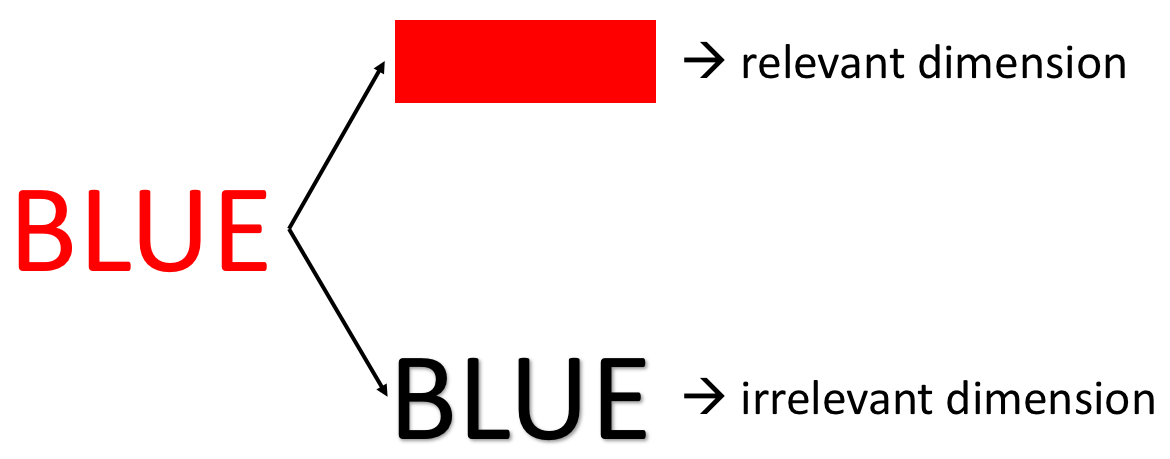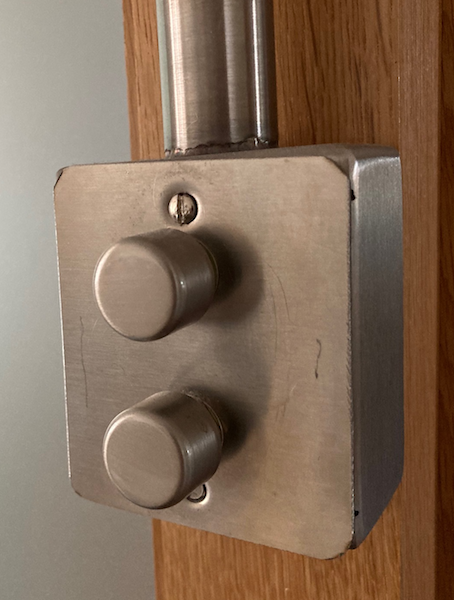Chapter 9 Interference tasks
9.1 Introduction
In interference tasks, there are at least two sources of information or dimensions presented to the participant; one of these is relevant and the other irrelevant. The most popular example of an interference task is the Stroop task. In the Stroop task, participants are typically instructed to indicate the colour of the word and to ignore the meaning of the word. Thus, the colour of the word is the relevant dimension, and the meaning of the word the irrelevant dimension (see Fig. 9.1).

Figure 9.1: Relevant and irrelevant dimensions in the Stroop task.
In a trial13, the two sources of information can be conflicting, in agreement, or they are unrelated. When they conflict, the trial is incongruent or incompatible. When they are in agreement, the trial is congruent or compatible. And when they are unrelated, the trial is neutral. Fig. 9.2 illustrates these three trial types for the Stroop task.

Figure 9.2: Incongruent, congruent and neutral conditions in the Stroop task.
When a trial is incongruent, the presence of both dimensions creates cognitive conflict that has to be resolved to give a correct response. Resolving this conflict takes time and effort. The interference effect is a measure of this time and effort. The interference effect can be expressed as a slowing down in response time. For example, we might say that participants were on average 200 ms slower in incongruent Stroop trials as compared to congruent Stroop trials. The interference resolution can also fail and the participant might give an incorrect response. Thus, an interference effect can also result in increased error rates. For example, we might say that the average difference in error rates in incongruent and congruent Stroop trials was 15%.
Interference effects are relevant for basic cognitive psychology as they reveal how well we are able to focus on relevant information and ignore irrelevant information. They are also relevant in applied contexts, for example when designing user interfaces for appliances, machines or software. Here is an example from my own home: There are two sets of lights in the dining area, one on the ceiling and one on the wall. Here is the light switch:

When we moved in, the switch on the bottom was for the light on the ceiling, and the switch on top for the light on the wall! This is an example of spatial stimulus-response incompatibility, and I can assure that this layout proved to be very confusing!
9.2 Read the research activity
For this activity, you will need to read parts of an empirical journal article. We think that it is really important that you start reading primary research literature early on in your course. As discussed in Chapter 2 of Beth’s book, empirical journal articles are the main way to communicate new findings in psychology. Not only do textbooks typically present a simplified picture, they also tend to lag behind new developments. This is not surprising given that it can take a few years before a new edition of a textbook is published. In addition, textbook authors frequently are not (and simply can not be) experts in all areas that their textbook covers. Thus, it might take years for them to pick up more recent developments that are not in their primary area of expertise14.
What is more, every primary research article is basically a lab report written by researchers. Therefore, if you want to develop an understanding of how lab reports should be written, it is a great idea to regularly read journal articles.
Please read Chapter 10 in Beth’s book before completing the activity below. You might also want to go over the section “Reading the Research” in Chapter 2 of Beth’s book again. I completely agree with everything Beth says, but would like to take up the cudgels for the method section, which in my view is the most underappreciated of all article sections. If you really want to understand what happened in a study, read the method section. If it is a well-written method section, it will provide you the deepest insights into what the researchers actually did.
The article you are about to read is about the flanker interference effect. The classic demonstration of the flanker interference effect was reported by Eriksen & Eriksen (1974). In the visual flanker task, there is a target that is usually presented in the middle of screen. Next to the target are the flankers. The target is relevant, the flankers are irrelevant. Similar to the Stroop task, target and flankers can be congruent, neutral or incongruent. The flanker effect refers to a slowing of RTs in incongruent relative to neutral or congruent trials and/or a decrease in accuracy in incongruent relative to neutral or congruent trials.
The classic version of the visual flanker task used letters. The version in the article below is slightly different from the classic version in that it uses letters and numbers. We have implemented this version on Pavlovia for you to try out. It should take less than 15 minutes to complete.
If you would like to try out the number-letter experiment on Pavlovia, please do so before downloading the article or reading the remainder of this chapter.
Please download the article by Avital-Cohen and Tsal.
Before you start reading the article:
- Think about which sections of the article might be most relevant to answering the questions below, and focus on these sections.
- Please note that to make it easier for you to identify the relevant parts of the article we have removed information pertaining to Experiment 2 from the article.
For Experiment 1 in Avital-Cohen and Tsal, please identify:
- The design (i.e., between-subjects or within-subjects)
- If between-subjects, posttest-only or pretest/posttest?
- If within-subjects, was there any counterbalancing employed? If yes, how was this done?
- The IV(s), and the levels of the IV(s) (see hint below if you get stuck)
- The DV(s)
- Constants
Optional:
- How many trials did the experiment consist of overall?
- Can you think of a follow-up experiment to further investigate the effect?
Please write your answers down and bring your notes to your lab class. In the lab class, you will be working in small groups to compare and discuss your answers with the aim to agree on one answer per question per group. After this, we will go over the questions, explain what the correct answers are and how to find the relevant information in the article.
Hint
Here is a hint for the question about the IV(s).
Note that there are two IVs in this experiment.
You can download a file with the correct answers here. The percentages of correct answers are based on last year’s cohort who submitted their answers online.
Note that there is a twist in how this article uses the flanker task: The flankers are either letters or digits. Critically, some flankers are ambiguous: They could be either numbers or letters (e.g., O could be the number 0 or the letter O). Avital-Cohen and Tsal show that these ambiguous letters only elicit an interference effect if participants interpret them as letters. This result is interesting because it is often believed that interference effects are automatic (i.e., they are not under voluntary control). Alternatively, one could say that researchers often believe these effects are a consequence of bottom-up processing (i.e., what happens is determined by the stimulus, not by your goals or the task instructions). On the contrary, Avital-Cohen and Tsal’s results show that top-down processing does influence the interference effect in the letter flanker task. This article is also a great example of how classic tasks can still be used to gain new insights!
References
Think of a trial as a stimulus-response cycle in an experiment. In the Stroop task, a trial begins when a colour word is presented. After a short time, the participant responds (e.g., by pressing a key on a keyboard). After the response, there might be a short break of a few 100 ms. This completes the trial. Overall, a trial in the Stroop task might take about 1 to 1.5 s. Clearly, this is very different from the meaning of the word “trial” in the context of a clinical trial where “trial” refers to the complete study. Make sure to distinguish these two meanings! Also, be aware that “trial” might be auto-corrected to “trail” by some pieces of software. If this does happen, you might want to tell your software that it should not auto-correct “trial”.↩︎
In this respect, edited books can be a better choice. Chapters in edited books are usually written by experts in a field.↩︎